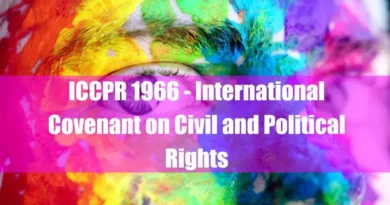I. What is ICERD 1965?
The ICERD, or International Convention on the Elimination of All Forms of Racial Discrimination, is a treaty adopted by the United Nations General Assembly in 1965. It aims to combat racial discrimination and promote understanding and equality among all races and ethnicities.
The Convention consists of 25 articles that outline various obligations for state parties to eliminate racial discrimination in all its forms. These obligations include ensuring equal rights before the law, combating hate speech and incitement to racial hatred, promoting tolerance and understanding among different racial and ethnic groups, and taking measures to eliminate racial segregation and apartheid.
In summary, ICERD is a significant international treaty to eradicate racial discrimination and promote racial equality. It comprises 25 articles outlining obligations for state parties to uphold these principles.
Here is a summary of ICERD 1965 articles:
- Article 1 defines racial discrimination.
- States (Article 2) condemn & pursue ending racial discrimination (all forms) & promote understanding.
- Article 3 bans racial segregation & apartheid.
- Article 4: States review & change laws promoting discrimination.
- Article 5 guarantees equal rights before the law (all).
- Article 6 ensures remedies for victims of racial discrimination.
- Article 7 promotes education to combat prejudice & build understanding.
- Article 8 tackles economic, social, and cultural discrimination.
- Article 9 (similar to Article 4) focuses on existing discrimination.
- Article 10: Public authorities follow the Convention & victims get remedies.
- Article 11 bans & punishes organizations promoting racial discrimination.
- Article 12: States ensure authorities fight discrimination by individuals/groups.
- Article 13: Laws promoting discrimination are void.
- Article 14: Cooperation with international organizations is encouraged.
- Article 15 establishes a committee of experts to oversee the Convention.
- Article 16: States report on their anti-discrimination efforts.
- Article 17: Disputes settled in court (International Court of Justice).
- Article 18: Alternative dispute resolution for disagreements between states.
- Article 19 (Optional): States can allow individuals to report discrimination.
- Article 20: The Committee considers reports from individuals alleging discrimination.
- Article 21: States respect Convention rights for all within their jurisdiction.
- Article 22 (Optional): States can avoid compulsory dispute resolution.
- Article 23: The Convention respects existing legal rights.
- Article 24: Affirmative action to address past discrimination is allowed.
- Article 25: No justification for racial discrimination is allowed.
II. History and Importance
A. Historical Context of ICERD
The genesis of ICERD can be traced back to the aftermath of World War II, a period marked by the horrors of racial persecution and genocide. The Nuremberg Trials brought to light the atrocities committed by the Nazi regime, igniting global consciousness about the perils of racial discrimination. Concurrently, the civil rights movement in the United States and anti-colonial struggles in Africa and Asia underscored the urgency of addressing racial injustice globally.
The United Nations recognized the imperative to codify principles safeguarding against racial discrimination in this milieu. The adoption of ICERD in 1965 represented a landmark achievement in international efforts to combat racism and promote human dignity. It was a pivotal moment in the trajectory of human rights law, reaffirming the commitment of the international community to uphold the principles of equality and non-discrimination.
Also, read:
- UDHR – Universal Declaration of Human Rights (1948)
- CEDAW 1979 – Convention on the Elimination of All Forms of Discrimination Against Women
- DEVAW 1993 – Declaration on the Elimination of Violence against Women
B. Importance and Purpose of ICERD
ICERD serves as a bulwark against racial prejudice and intolerance, enshrining the fundamental principle that all individuals are entitled to equal treatment irrespective of their race or ethnicity. ICERD seeks to foster inclusive societies where diversity is embraced and celebrated by establishing a universal standard for combating racial discrimination.
The significance of ICERD extends beyond legal obligations; it embodies a moral imperative to confront the systemic inequalities perpetuated by racial discrimination. By ratifying ICERD, states implement concrete measures to eliminate racial discrimination in all spheres of public life, including politics, education, employment, and access to justice.
Moreover, ICERD provides a framework for accountability, enabling the international community to monitor compliance and hold states accountable for their obligations. The establishment of the Committee on the Elimination of Racial Discrimination (CERD), tasked with overseeing the implementation of ICERD, underscores the commitment of states to uphold the principles enshrined in the Convention.
In essence, ICERD represents a beacon of hope in the fight against racial discrimination, embodying the collective aspiration for a world where everyone is treated with dignity and respect, regardless of race or ethnicity. As we navigate the complexities of a rapidly changing world, the principles espoused in ICERD remain as relevant and indispensable as ever, guiding our collective efforts toward a more just and equitable future.
III. Key Provisions of ICERD

The International Convention on the Elimination of All Forms of Racial Discrimination (ICERD) sets forth a comprehensive framework to combat racial discrimination and promote equality among all racial and ethnic groups. This section will delve into the key provisions of ICERD, including its definition of racial discrimination, the obligations imposed on state parties, and the fundamental rights guaranteed to individuals.
A. Definition of Racial Discrimination
ICERD provides a clear and encompassing definition of racial discrimination, encompassing various forms of discriminatory practices based on race, color, descent, or national or ethnic origin. According to Article 1 of the Convention, racial discrimination includes any distinction, exclusion, restriction, or preference that nullifies or impairs the recognition, enjoyment, or exercise of human rights and fundamental freedoms on an equal footing.
This definition encompasses both direct and indirect forms of discrimination, recognizing that discrimination can manifest in overt actions, policies, practices, and structures perpetuating inequality. By providing a comprehensive definition, ICERD lays the groundwork for states to effectively identify and address instances of racial discrimination.
Also, read:
- BPFA 1995: The Beijing Declaration and Platform for Action
- ILO Conventions: The International Labour Organization
- VDPA 1993: Vienna Declaration and Programme of Action
B. Obligations of State Parties
ICERD obliges state parties to eliminate racial discrimination and promote equality within their territories. These obligations are outlined in Articles 2 through 7 of the Convention and include:
- Taking effective measures to review and amend laws, policies, and practices perpetuating racial discrimination (Article 2).
- Prohibiting and eliminating racial segregation and apartheid (Article 3).
- Guaranteeing the right to equality before the law and ensuring equal protection of rights without discrimination (Article 5).
- Providing effective remedies for victims of racial discrimination and ensuring access to justice (Article 6).
- Undertaking measures to combat racial prejudices and promote understanding and tolerance among racial and ethnic groups (Article 7).
State parties must incorporate these obligations into their domestic legal frameworks and undertake proactive measures to address racial discrimination comprehensively. Moreover, ICERD emphasizes the importance of international cooperation in combating racial discrimination, highlighting the shared responsibility of the global community to uphold human rights principles.
C. Fundamental Rights Guaranteed
ICERD guarantees individuals various fundamental rights, irrespective of race or ethnicity. These rights, enshrined in Articles 5 through 7 of the Convention, include:
- The right to equal treatment before the law and equal protection of rights without discrimination (Article 5).
- The right to effective remedies for acts of racial discrimination (Article 6).
- The right to participate in cultural, social, and economic life on an equal footing (Article 5).
By affirming these rights, ICERD underscores every individual’s inherent dignity and worth, regardless of their racial or ethnic background. These rights serve as essential safeguards against racial discrimination, ensuring that all individuals have the opportunity to live free from prejudice and inequality.
In summary, the key provisions of ICERD lay the foundation for the comprehensive elimination of racial discrimination and the promotion of equality among all racial and ethnic groups. By defining racial discrimination, outlining state obligations, and guaranteeing fundamental rights, ICERD provides a robust framework for combating discrimination and advancing human rights globally.
Also, read:
- ICCPR 1966 – International Covenant on Civil and Political Rights
- ICESCR 1966 – International Covenant on Economic, Social, and Cultural Rights
- CRPD 2006 – Convention on the Rights of Persons with Disabilities
- CRC 1989 – Convention on the Rights of the Child
IV. Implementation and Enforcement

The effective implementation and enforcement of the International Convention on the Elimination of All Forms of Racial Discrimination (ICERD) are essential to its success in combating racial discrimination and promoting equality. This section will explore the mechanisms for implementation, the role of state parties, and the international oversight provided by the Committee on the Elimination of Racial Discrimination (CERD).
A. Mechanisms for Implementation
ICERD outlines various mechanisms to facilitate the implementation of its provisions at the national level. State parties are required to incorporate the principles of ICERD into their domestic legal frameworks and undertake legislative, administrative, and other measures to eliminate racial discrimination effectively. This may include enacting anti-discrimination laws, establishing specialized institutions, and implementing affirmative action policies to address systemic inequalities.
Furthermore, state parties must periodically submit reports to the Committee on the Elimination of Racial Discrimination (CERD) detailing the progress in implementing ICERD’s provisions. These reports allow states to showcase their efforts, share best practices, and identify areas for improvement in combating racial discrimination.
B. Role of State Parties
State parties are central in implementing and enforcing ICERD within their territories. They are responsible for upholding the principles enshrined in the Convention and ensuring that individuals enjoy equal protection under the law without discrimination based on race or ethnicity.
To fulfill their obligations under ICERD, state parties are expected to take proactive measures to prevent, prohibit, and eliminate racial discrimination in all spheres of public life. This includes adopting comprehensive anti-discrimination legislation, promoting diversity and inclusion, and providing effective remedies for victims of racial discrimination.
Additionally, state parties are encouraged to engage in dialogue and cooperation with civil society organizations, national human rights institutions, and other stakeholders to enhance the effectiveness of their efforts in combating racial discrimination.
C. International Oversight: The Committee on the Elimination of Racial Discrimination
The Committee on the Elimination of Racial Discrimination (CERD) is the primary mechanism for international oversight and monitoring of ICERD’s implementation. Composed of independent experts elected by state parties, CERD is tasked with reviewing state reports, issuing recommendations, and providing guidance on measures to combat racial discrimination effectively.
State parties are required to submit periodic reports to CERD detailing their compliance with ICERD’s provisions. Upon review of these reports, CERD may offer recommendations and observations to help states strengthen their efforts to eliminate racial discrimination.
Furthermore, CERD has the authority to consider individual and interstate complaints alleging violations of ICERD’s provisions. This provides an avenue for individuals and groups to seek redress for acts of racial discrimination and hold states accountable for their obligations under the Convention.
The effective implementation and enforcement of ICERD rely on a combination of national measures and international oversight. By adopting comprehensive anti-discrimination policies, engaging with stakeholders, and cooperating with CERD, state parties can advance the goals of ICERD and work towards eliminating racial discrimination on a global scale.
Also, read:
- GINA – Genetic Information Non-discrimination Act 2008
- 20 Quid Pro Quo Harassment Examples and How to Stop Them
- How to Prove Quid Pro Quo Harassment: 13 Powerful Evidences
V. Challenges and Criticisms

Despite its noble aspirations and comprehensive framework, the International Convention on the Elimination of All Forms of Racial Discrimination (ICERD) faces various challenges and criticisms in its implementation and effectiveness. This section will explore the contemporary challenges in eliminating racial discrimination, criticisms directed towards ICERD, and efforts to address the limitations of the Convention.
A. Contemporary Challenges in Eliminating Racial Discrimination
In the contemporary global landscape, racial discrimination persists as a pervasive and multifaceted issue, posing significant challenges to efforts aimed at its elimination. Some of the key challenges include:
- Structural Racism: Deep-rooted systemic inequalities and discriminatory practices continue to perpetuate racial disparities in various aspects of life, including education, employment, healthcare, and criminal justice.
- Emerging Forms of Discrimination: Advancements in technology and globalization have given rise to new forms of discrimination, such as online hate speech, algorithmic bias, and discrimination against migrants and refugees.
- Intersectionality: The intersection of race with other identity markers, such as gender, sexuality, and disability, exacerbates vulnerabilities and experiences of discrimination among marginalized communities.
- Resurgence of Far-Right Extremism: The resurgence of far-right ideologies and xenophobic movements in many parts of the world has fueled racial tensions and contributed to a climate of intolerance and hostility towards minority groups.
Addressing these contemporary challenges requires a multifaceted and intersectional approach that tackles the underlying drivers of racial discrimination while promoting inclusive policies and social cohesion.
B. Criticisms of ICERD
Despite its significance as a foundational instrument in the fight against racial discrimination, ICERD has faced criticism on various fronts. Some of the main criticisms include:
- Limited Enforcement Mechanisms: ICERD lacks robust enforcement mechanisms, relying primarily on state reporting and peer review processes to monitor compliance. This can lead to gaps in implementation and accountability, particularly in cases where states fail to uphold their obligations.
- Incomplete Coverage: While ICERD addresses racial discrimination comprehensively, some critics argue that the Convention does not adequately address intersecting forms of discrimination, such as those based on gender, religion, or sexual orientation.
- Lack of Universal Ratification: Despite being in force for over five decades, ICERD has not been universally ratified, with several countries, including major global powers, yet to become parties to the Convention. This limits the Convention’s reach and effectiveness in addressing racial discrimination on a global scale.
C. Addressing the Limitations of ICERD
Efforts to address the limitations of ICERD and strengthen its effectiveness in combating racial discrimination are ongoing. Some key strategies include:
- Enhancing Implementation: States parties should strengthen their implementation of ICERD’s provisions by enacting comprehensive anti-discrimination legislation, establishing robust accountability mechanisms, and promoting awareness and education on racial equality.
- Strengthening International Oversight: Efforts to strengthen the role and mandate of the Committee on the Elimination of Racial Discrimination (CERD) can enhance international oversight and monitoring of ICERD’s implementation. This may involve providing CERD with more significant resources, authority, and capacity to fulfill its mandate effectively.
- Promoting Universal Ratification: Encouraging countries that still need to ratify ICERD and promoting universal adherence to the Convention are essential for maximizing its impact and effectiveness in combating racial discrimination globally.
While ICERD has made significant contributions to the advancement of racial equality, it is not without its challenges and criticisms. Addressing contemporary challenges, addressing criticisms, and strengthening the implementation and oversight of ICERD are crucial steps toward realizing its vision of a world free from racial discrimination.
Also, read:
- Explaining Quid Pro Quo Harassment Under Title IX
- Quid Pro Quo Harassment: What It Is? Know Everything
- Title IX of the Education Amendments of 1972
- Understanding Racial Quid Pro Quo Harassment
VI. Successes and Impact

The International Convention on the Elimination of All Forms of Racial Discrimination (ICERD) has had significant successes and impacts in advancing the cause of racial equality worldwide. This section will examine case studies of successful implementation, the Convention’s impact on global efforts against racial discrimination, and recognition and awards garnered in acknowledgment of its contributions.
A. Case Studies of Successful Implementation
Numerous countries have successfully implemented ICERD’s provisions, resulting in tangible improvements in combating racial discrimination and promoting equality. Some notable case studies include:
- South Africa: Following the end of apartheid, South Africa ratified ICERD and implemented comprehensive anti-discrimination legislation, including the Promotion of Equality and Prevention of Unfair Discrimination Act. These efforts have contributed to dismantling institutionalized racism and fostering reconciliation and social cohesion.
- Canada: Canada’s multiculturalism policy and robust legal framework for combating discrimination have been instrumental in promoting racial equality and inclusion. The Canadian Human Rights Act, which prohibits discrimination based on race, ethnicity, and other grounds, reflects the country’s commitment to upholding ICERD’s principles.
- New Zealand: New Zealand’s Treaty of Waitangi Tribunal, established to address historical grievances of the indigenous Maori population, exemplifies the country’s commitment to addressing racial discrimination and promoting indigenous rights. The tribunal’s rulings have significantly improved Maori land rights and cultural preservation.
These case studies highlight the transformative potential of ICERD when coupled with strong political will, comprehensive legal frameworks, and proactive measures to address systemic inequalities.
B. Impact on Global Efforts Against Racial Discrimination
ICERD has played a pivotal role in shaping global efforts to combat racial discrimination and promote racial equality. Its principles and provisions have informed the development of regional and national anti-discrimination laws and policies, providing a normative framework for addressing racial inequalities.
Furthermore, ICERD has facilitated international dialogue and cooperation on issues related to racial discrimination, enabling states to share best practices, exchange information, and collaborate on initiatives to promote diversity and inclusion.
C. Recognition and Awards
ICERD and its contributions to advancing racial equality have been recognized and celebrated through various awards and accolades. These include:
- Nobel Peace Prize: In 1968, the United Nations received the Nobel Peace Prize in recognition of its efforts to promote peace and human rights, including its work on ICERD and other human rights treaties.
- UNESCO Prize for Human Rights Education: ICERD has been instrumental in promoting human rights education and raising awareness about the importance of combating racial discrimination. In recognition of its contributions to human rights education, ICERD has been honored with the UNESCO Prize for Human Rights Education.
- International Human Rights Awards: Numerous individuals and organizations working to promote racial equality and combat racial discrimination have been honored with international human rights awards, with many citing ICERD as a guiding framework for their work.
These recognitions underscore the enduring impact of ICERD in advancing the cause of racial equality and promoting human rights for all.
ICERD has achieved significant success and has had an impact in combating racial discrimination and promoting equality worldwide. Through successful implementation, global advocacy efforts, and recognition of its contributions, ICERD continues to serve as a beacon of hope in the ongoing struggle for racial justice and human dignity.
Also, read:
VII. ICERD in Contemporary Society
As we navigate the complexities of the modern world, the International Convention on the Elimination of All Forms of Racial Discrimination (ICERD) remains a cornerstone of international efforts to combat racial discrimination and promote equality. This section will explore the relevance of ICERD in contemporary society, its intersectionality with other forms of discrimination, and its role in addressing emerging forms of racial discrimination.
A. Relevance of ICERD in the Modern World
In an era marked by globalization, technological advancements, and shifting demographic trends, racial discrimination persists as a pervasive and evolving challenge. ICERD’s principles and provisions remain as relevant as ever in addressing the root causes of racial inequality and fostering inclusive societies.
ICERD provides a normative framework for combating racial discrimination across various spheres of public life, including education, employment, healthcare, and criminal justice. Its emphasis on equality before the law, non-discrimination, and effective remedies for victims of racial discrimination resonates with contemporary struggles for racial justice and human rights.
Moreover, ICERD catalyzes international cooperation and solidarity in confronting the shared challenges posed by racial discrimination. By promoting dialogue, exchange of best practices, and mutual support among states, ICERD contributes to building a more just and equitable world for all.
B. Intersectionality and ICERD
The intersection of race with other identity markers, such as gender, sexuality, disability, and socio-economic status, underscores the interconnected nature of discrimination and inequality. ICERD’s recognition of the intersectional nature of discrimination acknowledges the unique experiences and vulnerabilities faced by individuals who belong to multiple marginalized groups.
ICERD’s principles of non-discrimination and equality apply to race and intersecting forms of discrimination. By addressing the intersecting manifestations of discrimination, ICERD reinforces the importance of adopting an inclusive and intersectional approach to combating all forms of inequality and marginalization.
C. Addressing Emerging Forms of Racial Discrimination
Advancements in technology, communication, and migration have given rise to new forms of racial discrimination that warrant attention and action. From online hate speech and cyberbullying to algorithmic bias and discrimination against migrants and refugees, emerging forms of racial discrimination pose unique challenges that require innovative solutions.
ICERD provides a flexible and adaptable framework for addressing emerging forms of racial discrimination, offering principles and guidelines that can be applied to new contexts and challenges. By promoting awareness, dialogue, and cooperation, ICERD empowers states, civil society organizations, and other stakeholders to develop effective responses to emerging threats to racial equality.
ICERD’s relevance in contemporary society cannot be overstated. As we confront the enduring legacy of racial discrimination and grapple with emerging challenges, ICERD serves as a beacon of hope and guidance in our collective efforts to build a world free from racial prejudice and discrimination. By upholding its principles and values, we can work towards creating a more inclusive, equitable, and just society for future generations.
Also, read:
VIII. Conclusion
In conclusion, the International Convention on the Elimination of All Forms of Racial Discrimination (ICERD) is a pivotal instrument in the global fight against racial discrimination and promoting equality. Throughout its existence, ICERD has played a crucial role in shaping international norms, policies, and practices to eradicate racial prejudice and foster inclusive societies.
A. Recap of ICERD’s Significance
ICERD’s significance lies in its comprehensive framework for combating racial discrimination, its emphasis on equality before the law, and its promotion of understanding and tolerance among all racial and ethnic groups. By defining racial discrimination, outlining state obligations, and guaranteeing fundamental rights, ICERD provides a robust foundation for addressing systemic inequalities and promoting human dignity for all.
B. Future Outlook and Challenges
Looking ahead, the future outlook for ICERD remains both promising and challenging. While significant progress has been made in advancing racial equality, persistent challenges such as structural racism, emerging forms of discrimination, and the intersectionality of oppression require sustained attention and action.
Furthermore, the rise of populist movements, xenophobia, and hate speech underscores the ongoing relevance and urgency of ICERD’s principles in safeguarding against intolerance and prejudice. Efforts to address these challenges must be grounded in a commitment to upholding the values of ICERD and promoting social justice and human rights for all.
C. Call to Action
As custodians of ICERD’s principles, it is incumbent upon states, civil society organizations, and individuals to reaffirm their commitment to its implementation and enforcement. This entails adopting comprehensive anti-discrimination measures, promoting awareness and education on racial equality, and fostering dialogue and cooperation at the local, national, and international levels.
Furthermore, universal ratification of ICERD and strengthening its implementation mechanisms are essential steps toward realizing its vision of a world free from racial discrimination. By solidarity, we can build a future where everyone is treated with dignity, respect, and equality, irrespective of race or ethnicity.
ICERD embodies the collective aspiration for a world where racial discrimination has no place and diversity is celebrated as a source of strength and enrichment. As we continue our journey towards this vision, let us draw inspiration from the principles and values enshrined in ICERD and work tirelessly towards creating a more just, inclusive, and equitable world for all.
IX. Citation
International Convention on the Elimination of All Forms of Racial Discrimination. (n.d.). OHCHR. https://www.ohchr.org/en/instruments-mechanisms/instruments/international-convention-elimination-all-forms-racial









